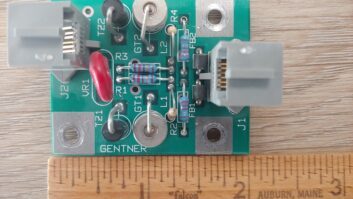Reaction was strong to the Steve Johnston commentary “Why I Support the Right to Repair.”
Hello Steve — saw your article today and was delighted to see your interest in “our” movement.

“You bought it. You own it. You should be able to fix it yourself or have it fixed at a shop of your choice.” That quote from the website of The Repair Association captures the sentiment of many RW readers.
iStockphoto/luchschen
The more people like yourself who fight against this ludicrous business model of monopolized repair, the more quickly we will be successful. There are 11 states now with bills filed, but only a couple of them have any serious support behind them. Every consumer in the U.S. is harmed by repair monopolies and has a personal reason to demand their right to repair.
After all, if you don’t want to fix your own stuff, you should still have the right to hire someone you trust to help.
People can go to our website and contact their legislators in any state through our advocacy tools https://repair.org/stand-up/.
Please feel free to contact me for additional information.
Gay Gordon-Byrne
Executive Director
The Repair Association
(Formerly The Digital Right to Repair Coalition)
North Haledon, N.J.
~ ~ ~
I have spent over 30 years in the broadcast engineering field, and I have also found that it is getting harder to get service information on the equipment we use.
There have been numerous times some piece of equipment would quit working just when it was needed for a production, and I would have to repair it without any service information.
As I have been told many times, engineers are like firefighters: We are the unsung heroes who always seem to be able to pull a rabbit out of our hat at the right time to save the day. One way or the other, we either get the equipment to work, or we come up with a temporary workaround.
Roger Newton, CSTE, CBNT
Chief Engineer
OETA(TV)
Tulsa, Olka.
~ ~ ~
A company that does not respect the “right to repair” will lose my support, and failure to provide service information is on its way out.
Bill Croghan, CPBE WBØKSW
Lotus Broadcasting
Las Vegas
~ ~ ~
File this under “Things You Paid For But You Can’t Touch”? Really!
For years, there have been stickers on equipment with the message “No user serviceable parts inside.” All the more reason to provide customer support, if the user can’t fix it. But they can’t have it both ways on user-serviceable parts. (“They denied there was a problem and would provide no technical details of their product.”)
Of course there are user-serviceable parts. I paid for it. I own it.
If they won’t fix it, don’t tell me I’m violating a warranty if I try to fix it and the company won’t either.
Because if the product was not defective in the first place, maybe from poor design or component failure, this need may never have arisen.
So I do own it. Except for the copyrights, of course. If this is a lease, then so disclose, change the terms and give me some money back!
As far as the phony excuse for competitors stealing the circuit, I am assuming the writer is talking about an American company operating under the protections of U.S. copyright law. They’re doing business here. How could they be unaware of this? Finding this out after you buy a product is a violation of sorts because it’s “changing the deal.”
Although a bit off-topic, there are other elements we have paid for that we as the owner/user cannot access, and for which some reimbursement should rightfully be in order. (Dare I mention the “FM chip”?)
There are a lot of similar frustrating experiences many of us share that are “second cousins” to this situation. Like spending $6,000 or $7,000 on a hearing aid that you’re not allowed to adjust yourself. Excuse me? I bought it. Paid for it. Took it home. I adjusted the equalizer on my car stereo on my way home … You get my drift.
Don Elliot
Owner
Levine/Schwab Broadcasting
KWIF(AM)
Hollywood, Calif.
As far as I’m concerned, until the manufacturers give their equipment away, we have the right to fix it!
There are virtually no service manuals available for anything anymore. Sure, a new major product is just a computer masquerading as a piece of broadcast equipment, but there is still a need to know — a need to know how it works, what’s inside, how it interfaces … If there is a fuse invisible to the naked eye, I still want to know.
And by the way, if they are going to give their equipment away, they should give us two. We need a spare to stay on the air while we wait for the factory to respond to a service request.
Robert White
43 years in broadcasting
~ ~ ~
I wholeheartedly agree with Steve Johnston’s position.
This is exactly why every Henry Engineering product includes a schematic diagram and still uses “old school” through-hole components instead of surface-mount parts. SMT is cheaper to manufacturer but virtually impossible to repair.
Very few radio station engineering departments have the equipment or expertise necessary to remove and replace SMT components without destroying a product’s PC board in the process. And needless to say, SMT ICs cannot be tested once removed, so it’s a lost cause to even try.
We still use DIP ICs, mounted in sockets, for very quick and easy replacement. ICs seldom fail, but when they do, it’s a simple repair to replace a 50-cent IC by simply plugging it in. You’re “back in business” in minutes, rather than sending a product back to the manufacturer for repair or buying a new unit because it’s not repairable by either the station engineer or the manufacturer.
Sometimes there’s wisdom in keeping things “old school,” especially if you’re the “student” responsible for keeping a radio station on the air!
Hank Landsberg
Henry Engineering/
Sine Control Technology Inc.
Seal Beach, Calif.
~ ~ ~
I agree with Steve Johnston’s commentary regarding the need for servicing documentation for a newly purchased product.
I, too, have been faced with having to discard an expensive UPS because the manufacturer refused to provide schematics, parts list and other critical information that would have allowed me to repair the unit. I shipped the unit to them for repair (at a cost of $300 for express delivery) only to be told they do not repair these.
In another case, I was forced to replace a controller PC board in a generator at a cost of $750 because the manufacturer would not provide service information. The part numbers of the chips on the board had been mutilated, which disallowed any reverse engineering efforts.
The pace of technology change is rapid. This means products are being improved, updated and replaced by new introductions; older models are no longer supported by the manufacturer, and some manufacturers are no longer in business. This leaves customers to fend for themselves when it comes to service, maintenance and repair.
Documentation is critical to that process. While I do understand a manufacturer’s concern that a competitor may benefit from some information, it is also commonsense to realize they may do so without it being handed to them (i.e., reverse engineering).
In an extreme case, I am told that owners of a major brand of tractor are warned against performing certain repairs on equipment they have purchased due to possible violation of the Digital Millennium Copyright Act.
If I buy a product, I expect proper and accurate documentation.
In the case of surface-mounted components, it may not be possible to field repair or even diagnose a problem due to the small size of the component leads. Removing and replacing the failed component is another challenge, unless you have the proper equipment.
It is unfortunate that many times we are faced with needing components that have become “unobtanium” because they are no longer manufactured. We should not however be encumbered by lack of documentation that would enable us to maintain and repair that for which we have paid.
A client compensates me to perform repairs, calibration and maintenance. If I simply told them to return the equipment to the manufacturer, why would they need me?
I consider myself qualified and educated to perform diagnoses and repairs, and I require the documentation to do so. A manufacturer who disagrees with that philosophy will not have the benefit of my business or recommendation.
Tom Osenkowsky
Brookfield, Conn.
~ ~ ~
Long overdue has been a public airing of such an astute opinion as that brought by Steve Johnston.
During my nearly 50 years of working in radio, I have become increasingly frustrated by the diminishing availability and quality of documentation about things that need to be repaired. I recall the days when it was common to have an accurate schematic diagram enclosed with the packaging of most professional and many consumer electronic items.
Fortunately, it seems that many manufacturers of broadcast-related equipment realize the need to provide well-detailed operation and maintenance documentation, including block and schematic diagrams. Over the years some of us have learned a good bit about electronics from the excellent functional descriptions and diagrams provided by manufacturers of broadcast equipment. Large-scale integration and microprocessors are sort of like the “black boxes” of earlier times but all of these yet require supportive circuitry, which is often the point of failure that can be repaired — a task that is much easier if we have the “road maps.” Give me a diagram and I’ll decide whether I need to spend money for a factory or other repair.
The implication that users do not own the right to do whatever they wish with their purchased property is a repulsive indication of how our society has a diminishing view of those who, without some sort of “certification” or “title” are somehow thought to be dullards who must be protected (read: manipulated) for their own good or, perhaps more correctly, for the profit of those who practice this kind of manipulation. Incomplete documentation may function to the detriment of those whose equipment we choose not to purchase for lack of it.
Nels Wilson
KBGN(AM)
Caldwell, Idaho
~ ~ ~
There’s another good reason that manufacturers should provide schematic information: Device compatibility.
We engineers deploy devices from different manufacturers in systems, connecting them one to another. Sometimes “middleware” is needed, like a gain block or logic level shift. Knowing the internal architecture behind the external connections makes that a much less uncertain process. It probably avoids warranty repairs and support calls as well.
Frank McCoy
Chief Engineer
Salem Chicago










